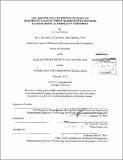Age, movements, and feeding ecology of northwest Atlantic white sharks estimated from ecogeochemical profiles in vertebrae
Author(s)
Hamady, Li Ling
DownloadFull printable version (34.29Mb)
Other Contributors
Woods Hole Oceanographic Institution.
Advisor
Simon R. Thorrold.
Terms of use
Metadata
Show full item recordAbstract
White sharks (Carcharodon carcharias) are highly migratory, ecologically important, vulnerable, and understudied marine predators. Ecogeochemistry, which takes advantage of natural variations in chemical signatures recorded in body tissues, can help determine lifetime movement, age, and ontogenetic diet history in difficult to study species. Shark vertebrae are constructed of distinct layers of tissue laid down sequentially over an individual's lifetime and may preserve a chemical record of environmental exposure. In this thesis, I investigate the ecology of the understudied northwest Atlantic (NWA) white shark population by applying several ecogeochemistry techniques to their vertebrae. I generate the first radiocarbon ([delta]¹⁴C) age estimates for adult white sharks, dramatically extending the maximum age and longevity compared to earlier age studies. [delta]¹⁴C results also verify a lack of reworking of vertebral material and hint at possible sexual dimorphism in growth rates. Using amino acid and bulk stable isotope analyses, I show that individual sharks have marked variation in feeding and movement, and that pinnipeds do not constitute a large portion of their diet. Finally, I explore the utility of elemental chemistry to retrospectively infer movement. This work provides an important informational baseline for future NWA white shark ecological studies and conservation and management efforts.
Description
Thesis: Ph. D., Joint Program in Oceanography/Applied Ocean Science and Engineering (Massachusetts Institute of Technology, Department of Biology; and the Woods Hole Oceanographic Institution), 2014. Cataloged from PDF version of thesis. Includes bibliographical references (pages 113-127).
Date issued
2014Department
Joint Program in Oceanography/Applied Ocean Science and Engineering; Woods Hole Oceanographic Institution; Massachusetts Institute of Technology. Department of BiologyPublisher
Massachusetts Institute of Technology
Keywords
Joint Program in Oceanography/Applied Ocean Science and Engineering., Biology., Woods Hole Oceanographic Institution.